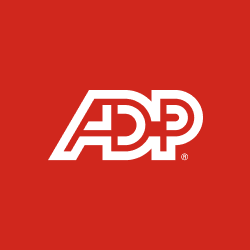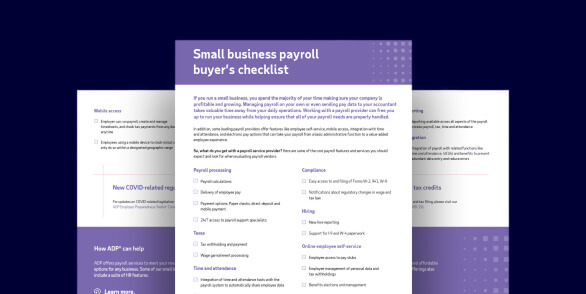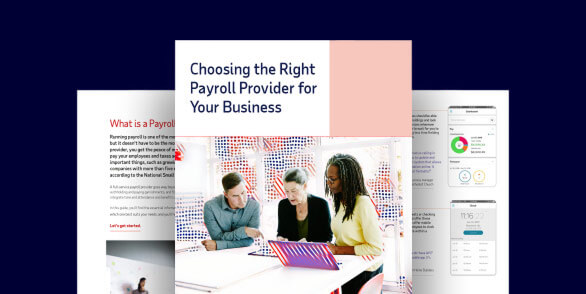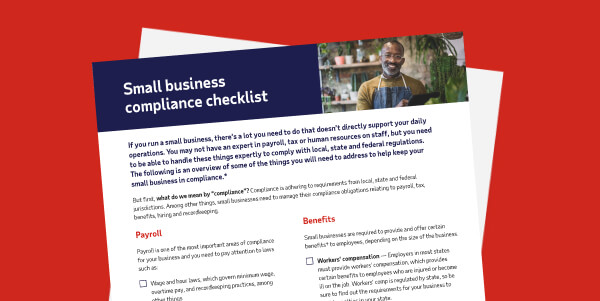guidebook
How to start a small business
Interested in fast, easy payroll for your new business?
You have a winning idea plus the passion and skills to make it a success. But the process of actually getting your business off the ground can be overwhelming. Trust us, you’re not alone.
As you continue to perfect your business idea, here are a few things to keep in mind to help you get off to a smart start.
Table of Contents
What do you need to start a small business?
Every successful business started from the ground up. No matter how eager you are to get a product into market, taking the time to create a solid foundation now will help increase the chances of your business surviving long-term. Some of the basic things you may need to start a small business include:
- Idea backed by market research
- Business plan
- Funding and bank account
- Business structure (corporation, LLC, etc.)
- Doing business as (DBA) name
- Employer identification number (EIN)
- Business location
- Licenses and permits
- Insurance policies
What is a good business to start?
A good business to start is usually one that fills an unmet consumer need. Think of any everyday problem that’s yet to be solved or ways to improve an existing solution by making it faster, cheaper or easier to use. Preferably, your idea should be something that you’re passionate about or have some existing level of expertise.
Choosing the entrepreneurship that’s right for you will also depend on your financial situation. Some businesses, such as dog walking, have low start-up costs, while others, like a restaurant, may require considerable investment. And if you’re looking for a get rich quick scheme, you may be disappointed. Most small businesses take considerable time and effort before turning a profit.
Starting a business from home
Many entrepreneurs start a small business because they like the idea of working from the comfort of their home and setting their own hours. And while this is a great perk, it also limits the type of business you can create. Manufacturing products, for example, might not be feasible from your living room. Additionally, you may need to consider the zoning and legal restrictions in your particular neighborhood, and how your business will affect your neighbors and those who live with you.
How to start your own small business
Taking an idea to market or making a dream become reality typically takes a series of carefully planned business decisions. While not every small business follows the same path, these twelve steps can help you get started:
- Perform market research around your idea
- Create a business plan
- Finance your business
- Choose your business structure
- Choose your business name
- File registration documents
- Apply for EIN or tax ID
- Open a small business bank account
- Obtain any necessary licenses or permits
- Choose your accounting and payroll system
- Create a web presence
- Choose retirement and health insurance plans
Step 1: Perform market research around your idea
Market research can help you mitigate risk because it lets you know how much of a demand there is for your product or service and the level of existing competition. It also provides demographic information on your target customers, such as their income and where they live.
You generally have two options when it comes to research – review existing sources or conduct your own analysis. Relying on previously gathered data can save you time and money, but it might not be current or specific enough to your target clientele. If you start your research from scratch, you have the advantage of engaging with customers directly through focus groups, one-on-one interviews and surveys.
Step 2: Create a business plan
A business plan explains your goals and how you hope to achieve them. If you need funding for start-up costs, many investors will want to see your plan so they can assess your potential profitability. Business plans can also help you attract partners and employees.
When creating a business plan, you can take a traditional approach or create something lean. Traditional plans have comprehensive details and are often required to achieve a business loan. Lean plans, on the other hand, are shorter and may use more charts than written copy. They’re often ideal for simple business models that plan to start up fast.
Whichever plan you choose for your new business, most include at minimum:
- A description of your product, it’s value proposition and how you plan to market it
- How much investment you require and the amount of revenue you expect to make
- Your target audience and the customer experience

Start strong with small business payroll & HR
Simplify payroll & HR from Day 1 with ADP's all-in-one solutions.
Step 3: Finance your business
Start-up costs are one of the obstacles that sometimes prevent people from ultimately pursuing their dream. The good news, however, is that even if you don’t have much money at your disposal, there are several ways to fund your business, including:
- Bootstrapping
Self-funding is advantageous because you maintain complete control of your business. On the downside, it sometimes comes with the highest personal financial risk. - Venture capital investments
Venture capitalists or “angel investors” may be willing to fund your business, but they usually expect membership on your board of directors or some stake in the company. You may need a detailed business plan to secure a capital investment. - Small business loans
If you don’t have enough money, but still want to keep full ownership of your business, a loan might be advantageous. Be prepared to show banks and credit unions a comprehensive business plan, as well as your estimated expenses and financial projections. - Crowdfunding
Some people invest in a business in exchange for perks, as opposed to a share of the profits or company ownership. Because these perks are usually merchandise or name recognition, your business may need to be in the general consumer product or creative industries to take advantage of crowdfunding.
Step 4: Choose your business structure
How you plan to structure your business – sole proprietor, corporation or something in between – will typically have legal and tax implications for the foreseeable future. That makes this decision a critical one. Some of the more popular business structures are:
- Sole proprietorship
This is the most common structure for solo entrepreneurs or “solopreneurs.” - Partnership
If you are starting a business with one or more individuals, then a partnership structure might be right for you. - Limited liability company
An LLC blends the limited liability features of a corporation with the tax efficiencies and operational flexibility of a partnership. - Cooperative
A cooperative is a business or organization owned and operated for the benefit of those using its services. Companies in health care, retail, agriculture, art and restaurant industries fall in this category. - Corporation
Corporations are more complex from a legal and tax standpoint and are therefore more common among larger companies. - S corporation
Eligible domestic corporations can sometimes avoid double taxation (one tax for the corporation and another for the shareholders) by electing to be treated as an S corporation.
Step 5: Choose your business name
After you’ve determined your structure, it’s time to decide how your business will be recognizable to the public. Your business name should:
- Reflect your brand and values
- Convey the services you provide or products you sell
- Work as a logo and resonate on social media and other marketing platforms
You’ll also want to make sure your business name isn’t already taken. Contact your state filing office or search your state’s online database to verify availability. Even if the name isn’t in use, it may still be protected under trademark, so you may also want to check with the U.S. Patent and Trademark Office’s (USPTO).
Once you’ve settled on a name that suits your organization and confirmed its availability, you should trademark it and purchase a recognizable version of it as a domain name. Then, create a presence on social media channels (LinkedIn, Twitter, Facebook, Instagram, etc.) by opening accounts with your business name.
Additionally, some business structures require a doing business as (DBA) name, which is a fictitious or assumed name that’s different from your business entity name. A DBA may sometimes be necessary to open a business bank account.
Step 6: File registration documents
Registering your small business with the government may not always be necessary, but it might avail you to personal liability protection and legal and tax benefits.
Federal registration
Other than a tax ID number, you usually don’t need to register your business with the federal government unless you’re applying for tax exempt status or trademark protection.
State registration
You may be required to register in the state where your business was formed and any other states that you operate in, also known as foreign qualification. Registration documents vary by state and business structure, but most typically ask for:
- Business name
- Location
- Owner or management structure
- Name of registered agent
- Total number and value of shares, if applicable
Local registration
Most local governments don’t mandate that businesses register with them, but certain business structures may need to apply for licenses or permits.
Explore Get your payroll tax ID with ADP
Step 7: Apply for EIN or Tax ID
As soon as your business is registered, you might want to apply for an employer identification number (EIN) from the IRS. This number is necessary so you can file your federal taxes, hire employees and in some cases, open a business bank account. You can apply for an EIN on the IRS website.
In addition, some states have their own tax ID numbers, which you may need to pay state income tax and unemployment tax. Check with your state for the specific application process, or try ADP’s payroll tax registration services.
Step 8: Open a small business bank account
You’re going to need somewhere to deposit all those hard-earned dollars, but what type of account best fits your current requirements and future goals? Given that you’re just starting out, you may need:
- A simple checking account with no or low monthly fees
- A bank that offers convenient locations and hours of operation
- Online banking and mobile apps to help you manage your money on the go
- Loan products should you need some growth capital now or in the future
How to open a bank account
After you’ve found a bank that suits your needs, gather the necessary paperwork to open a business account:
- Official business formation documents
- EIN or tax ID numbers
- Business name and location
- Date the business was established
- Business owner’s Social Security number, address and date of birth
How to apply for financing
Particularly at the start, you may need to apply for a business line of credit to keep things moving. These short-term loans are useful for bridging temporary working capital needs, such as inventory purchases or operating expenses.
To apply for a line of credit you usually need to provide the bank with proof of revenue. If approved, they may set a limit, which like a credit card, allows for continuous borrowing and repayment within the agreed duration of the loan.
Step 9: Obtain any necessary licenses or permits
Before you open for business, take a moment to make sure that you have all the correct licenses, permits and insurance policies to operate legally. The last thing you want at this stage is to be shut down by a government agency.
Which licenses and permits do you need?
If your business operates in certain industries, such as agriculture and broadcasting, you might need a federal license. Other industries, like health care, typically require professional licenses. Even if you don’t fall into one of these categories, you may need some form of permission to conduct business. Freelancers and consultants, for example, sometimes have to have a home occupation permit.
Which insurance do you need?
Your insurance needs will depend on what type of business you have, but there are also requirements that vary from state to state. Examples of types of insurance you may need to consider include:
- Workers’ compensation
Mandatory in most states, workers’ compensation provides coverage for on-the-job injuries or illness. Employees typically receive wage replacement and medical benefits in exchange for mandatory relinquishment of their right to sue for negligence. Learn about Pay as You Go Workers’ Comp. - General liability insurance
This insurance usually covers accidents, injuries and claims of negligence. - Product liability insurance
Often essential for businesses in manufacturing or distribution, product liability helps protect against financial loss due to a defective product that causes injury or bodily harm. - Professional liability insurance
If you provide a service, professional liability, or errors and omissions insurance, helps safeguard you from malpractice and negligence lawsuits. - Commercial property insurance
Property damage and loss caused by fire, smoke, storms, vandalism and other events are usually covered by commercial property insurance. - Business owner policy
Designed for small and medium-sized businesses, BOP combines general liability insurance and property insurance into a single, more cost-effective policy.
Explore Learn more about ADP's business insurance services
Step 10: Choose your accounting and payroll system
Before you make an initial sale or hire your first employee, you most likely need a method of managing your finances and paying the people who work for you. You can tackle these important tasks yourself using spreadsheets, hire an accountant or work with a payroll provider.
If you’re a solo operation or only have a few employees, a manual approach to payroll may save you money. It is, however, time consuming and comes with the most risk because you could be fined for mistakes. Hiring an accountant might give you more peace of mind, but they’re usually expensive and you may lose some control of the process. A payroll provider, on the other hand, is often the best of both worlds, giving you control and risk reduction, while also saving you time.
Payroll providers like ADP offer products that in most cases, can automatically pay your employees, file taxes on your behalf and help you comply with applicable government regulations. Our payroll also seamlessly integrates with many types of accounting software so you can manage your finances from one place. A provider like ADP serves business of all sizes so whether you need payroll for a small business or something larger, we can help.
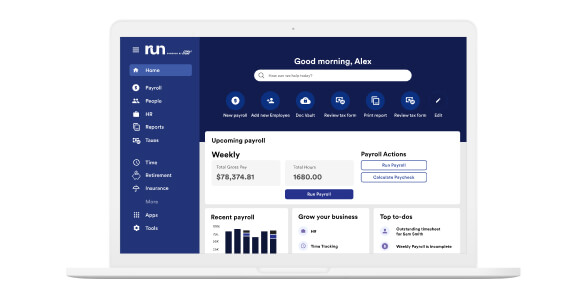
Get the right tools to run your business: RUN Powered by ADP
Take the hassle out of payroll and HR from the get-go with RUN Powered by ADP. See for yourself.
Step 11: Create a web presence
Since most customers use the internet to search for goods and services, a helpful and attractive website can be an integral piece of your marketing strategy. The ideal web presence should:
- Engage your target audience
- Include key terms for search engine optimization (SEO)
- Display your business logo
- Have creative content
- Integrate social media channels
Although there are some platforms that allow you to build a site with little or no development knowledge, it may be worth hiring a professional if you want to present a truly polished image of your business. Look for digital agencies that specialize in helping small businesses because they’re usually more likely to understand your needs and meet your budget requirements. Additionally, some payroll & HR providers like ADP offer marketing and consulting services, so check your packages to ensure you’re taking advantage of all the benefits.
Starting an online business
A website is even more critical if your business will be conducted entirely online. You have several options in this regard:
- Ecommerce store
Sell your own inventory of products directly to customers. - Drop shipping
Work with a third party distributor to fulfill your sales orders. - Affiliate marketing
Drive traffic to ecommerce sites and make commission on sales. - Blogging
Create engaging content that generates revenue from advertisements.
Step 12: Choose retirement and health insurance plans
You might want to review your health insurance and retirement plan options as soon as possible because they can help you attract employees. Even if you don’t or won’t have employees, you may still want to consider benefits for yourself as the business owner.
How to choose a health insurance plan
When shopping for health insurance, look for a plan that:
- Meets your desired level of coverage (medical discount, limited or full-feature plan)
- Compiles with the Affordable Care Act (ACA)
- Offers access to all the services you need (specialists, mental health, etc.)
- Has co-pays, deductibles or out-of-network expenses within your budget
How to choose a retirement plan
When considering retirement plans, small businesses generally have three options:
- Simplified employee pension plan (SEP-IRA)
- Simple IRA
- Solo 401(k)
Each of these retirement plans has different contribution limits. To determine which makes sense for you, consider your savings goals, the time scale and if you anticipate needing access to the money before retirement. Consult with a small business banker or financial advisor or visit the IRS website for more help making an informed choice.
How to start payroll for a small business
To get started with payroll, whether you’ve chosen to do it yourself or work with a payroll provider, you may need to:
- Apply for tax ID numbers
- Gather employee information (Forms W-4, I-9, etc.)
- Create a payroll calendar
- Have a method of tracking employee hours
- Open a separate bank account for payroll
How to pay employees
You can compensate your employees using paper checks, direct deposit and alternative methods, like paycards. But how do you get from the first day of a pay cycle to the all-important pay day? Following these basic steps may help:
- Determine employee hourly wage
- Track hours worked
- Calculate gross pay
- Withhold pre-tax voluntary deductions, such as health benefits
- Deduct mandatory payroll taxes
- Withhold post-tax deductions, such as garnishments
- Distribute payment and paystub
- Keep detailed payroll records
This process may sound simple, but it often becomes complex as you hire more employees. Working with a payroll provider may save you time and prevent costly mistakes.

Start strong with small business payroll & HR
Simplify payroll & HR from Day 1 with ADP's all-in-one solutions.
How to do payroll for self-employed
If you’re a solopreneur or independent contractor, you can usually pay yourself directly from your profits. Depending on your total earnings, however, you may have to pay income tax and self-employment tax, which is a combination of Medicare and Social Security taxes. These taxes are, in most cases, filed quarterly using IRS Form 1040-ES.
Starting a small business FAQs
See what other entrepreneurs ask about starting a small business:
Can you start a business with no money?
As long as you’re willing to put in the effort, it may be possible to start a business with limited or no funds. Service-based businesses are sometimes a good option for cash-strapped entrepreneurs, especially if you have expertise in a specific area or already own the tools needed to perform the job. Product-based businesses usually require more capital, but you can still pursue them in some cases by starting a service business and using the profits to launch a product. Along the way, you typically need to do all the work yourself and may have to keep your existing job to avoid financial hardship.As long as you’re willing to put in the effort, it may be possible to start a business with limited or no funds. Service-based businesses are sometimes a good option for cash-strapped entrepreneurs, especially if you have expertise in a specific area or already own the tools needed to perform the job. Product-based businesses usually require more capital, but you can still pursue them in some cases by starting a service business and using the profits to launch a product. Along the way, you typically need to do all the work yourself and may have to keep your existing job to avoid financial hardship.
What is the easiest business to start?
Businesses where you perform a service – landscaping, graphic design, consulting, etc. – are usually the easiest to start because they require the least initial investment. They also tend to be more profitable compared to product-based businesses that have overheard expenses. And if you choose a service that suits your existing skill set, you can sometimes be up and running fairly quickly. Another advantage to service-based businesses is that many of them can be done as a side job, so there may be less financial risk.
How much does it cost to open a business?
Startup costs generally vary greatly depending on the type of business you plan to open. Some businesses need office space, others require specialized equipment and most today need a website. As an entrepreneur, you need to carefully estimate these expenses ahead of time. This will help determine how you’ll finance your business and may reduce your chances of running out of money before you turn a profit.
Ready to start your small business?
Let the experts at ADP help you start on the right foot with payroll, tax, compliance, HR and more – all backed by the experts.
Next steps for starting your small business
Now that you understand how to start your small business, it's time to take the next step with confidence. ADP is here to support you at every stage of your journey. From managing payroll and human resources to ensuring compliance and enhancing employee benefits, our solutions streamline your business operations and help you succeed. Contact us today to see how we can help you get started.
Want more exclusive business insights like this delivered to your inbox?Subscribe now
1. ZipRecruiter is a registered trademark of ZipRecruiter, Inc.
2. Legal services are provided by Upnetic Legal Services, a third-party provider


